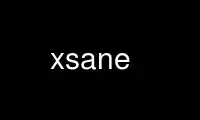
This is the command xsane that can be run in the OnWorks free hosting provider using one of our multiple free online workstations such as Ubuntu Online, Fedora Online, Windows online emulator or MAC OS online emulator
PROGRAM:
NAME
xsane - scanner frontend for SANE
SYNOPSIS
xsane [--version|-v] [--license|-l] [--device-settings file |-d file] [--viewer|-V]
[--save|-s] [--copy|-c] [--fax|-f] [--mail|-m] [--no-mode-selection|-n] [--Fixed|-F]
[--Resizable|-R] [--print-filenames|-p] [--force-filename name |-N name] [--display d]
[--sync] [devicename]
DESCRIPTION
xsane provides a graphical user-interface to control an image acquisition device such as a
flatbed scanner. It allows previewing and scanning individual images and can be invoked
either directly from the command-line or through The GIMP image manipulation program. In
the former case, xsane acts as a stand-alone program that saves acquired images in a
suitable PNM format (PBM for black-and-white images, PGM for grayscale images, and PPM for
color images) or converts the image to JPEG, PNG, PS or TIFF. In the latter case, the
images are directly passed to The GIMP for further processing.
xsane accesses image acquisition devices through the SANE (Scanner Access Now Easy)
interface. The list of available devices depends on installed hardware and configuration.
When invoked without an explicit devicename argument, xsane presents a dialog listing all
known and available devices. To access an available device that is not known to the
system, the devicename must be specified explicitly. The format of devicename is
backendname:devicefile (eg: umax:/dev/sga).
RUNNING UNDER THE GIMP
To run xsane under the gimp(1), you should at first make sure that xsane is compiled with
gimp support by entering "xsane -v" on a shell. If xsane is compiled with gimp support
then simply set a symbolic link from the xsane-binary to one of the gimp(1) plug-ins
directories. For example, for gimp-1.0.x the command
ln -s /usr/bin/xsane ~/.gimp/plug-ins/
for gimp 1.2.x the command:
ln -s /usr/bin/xsane ~/.gimp-1.2/plug-ins/
and for gimp 2.0.x the command:
ln -s /usr/bin/xsane ~/.gimp-2.0/plug-ins/
adds a symlink for the xsane binary to the user's plug-ins directory. After creating this
symlink, xsane will be queried by gimp(1) the next time it's invoked. From then on, xsane
can be invoked through "Xtns->XSane->Device dialog..." (gimp-1.0.x) or through
"File->Acquire->XSane->Device dialog..." (gimp-1.2.x and 2.0.x) menu entry.
You'll also find that the "Xtns->XSane" or "File->Acquire->XSane" menu contains short-cuts
to the SANE devices that were available at the time the xsane was queried. Note that
gimp(1) caches these short-cuts in ~/.gimp/pluginrc. Thus, when the list of available
devices changes (e.g., a new scanner is installed or the device of the scanner has
changed), then it is typically desirable to rebuild this cache. To do this, you can
either touch(1) the xsane binary (e.g., "touch /usr/bin/xsane") or delete the plugin cache
(e.g., "rm ~/.gimp/pluginrc"). Either way, invoking gimp(1) afterwards will cause the
pluginrc to be rebuilt.
When xsane is started from the gimp then it is not possible to add a devicename
explicitly. You have to make the devices known to the system by configuring sane-dll,
sane-net and saned.
OPTIONS
If the --version or -v flag is given xsane prints a version information, some information
about gtk+ and gimp version it is compiled against and lists the supported file formats,
then it exits.
when the --license or -l flag is given xsane prints license information and exits.
The --device-settings or -d flag reads the next option as default filename for device
settings. The extension ".drc" must not be included.
The --viewer or -V flag forces xsane to start in viewer mode.
The --save or -s flag forces xsane to start in save mode.
The --copy or -c flag forces xsane to start in copy mode.
The --fax or -f flag forces xsane to start in fax mode.
The --mail or -m flag forces xsane to start in mail mode.
The --no-mode-selection or -n flag disables the menu for xsane mode selection (viewer,
save, copy, fax, mail).
If the --Fixed or -F flag is given then xsane uses a fixed, non resizable main window.
The flag overwrites the preferences value.
If the --Resizable or -R flag is given then xsane uses a scrolled and resizable main
window. The flag overwrites the preferences value.
If --print-filenames or -p flag is given then xsane prints the names of created files to
the standard output.
When the flag --force-filename or -N is given then xsane reads the next option as default
image filename. The name should be of the format "name-001.ext". (or any other number
instead of 001) that 001 part will be used as a filename counter if xsane is so
configured. Beware that the number of digits must correspond to the configuration of
xsane. The selection box for filenames is disabled. This option normally should be used
with the option --no-mode-selection and --save.
The --display flag selects the X11 display used to present the graphical user-interface
(see X(1) for details).
The --sync flag requests a synchronous connection with the X11 server. This is for
debugging purposes only.
ENVIRONMENT
SANE_DEFAULT_DEVICE
is used to preselect the device in the device dialog. This way you only have to
accept the device (<ENTER> or OK-Button).
Use xsane online using onworks.net services
